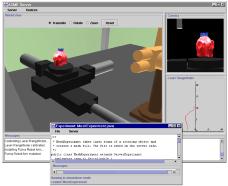
ACME Software
The overall architecture is shown in the figure. With the exception of real-time control software, everything in ACME is implemented in Java 2. Users can interact with the facility using the ACME Client from any location on the Internet. The robotic subsystems are controlled by the ACME Server. A key feature is the teleprogramming provided by ACME Experiment objects, which allow time-critical sensing and control to be achieved despite latencies inherent in communication over the Internet.ACME Server
The server implements Java objects called Devices, which include Actuators and Sensors. Actuators are robotic subsystems which can be controlled as a unit (see Facility). Sensors are sources of measurement data, such as the Triclops range camera, and the CMS's 6 axis force/torque sensor. An event-based mechanism is used control real-time data acquisition.
ACME Client
The client provides both a simple development environment for designing and controlling ACME Experiments, as well as a simulator. A graphical viewer renders the state of the ACME facility (either real or simulated) and the state changes as an experiment proceeds. The complete ACME client is a 100% pure Java program enabling its use on any system with an Internet connection and a Java virtual machine. The optional viewer is implemented in Java3D.